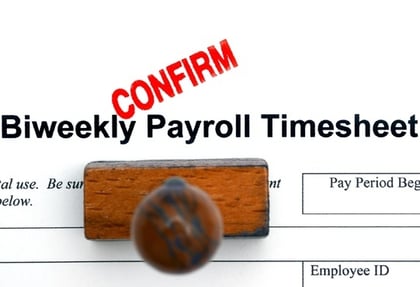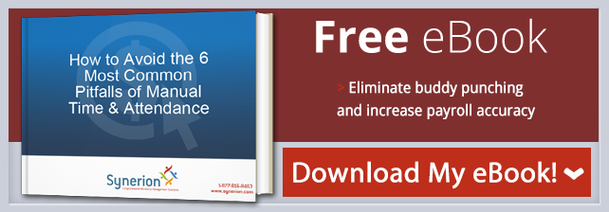 With the average employee stealing 4 hours and 5 minutes every week, getting a handle on your timesheets is essential. Yet many businesses don't realize that this immense cost can take almost five percent of their own payroll expenses annually and may be easier than they think. Stop time theft today by identifying these six ways your employees could be manipulating their timesheets.
With the average employee stealing 4 hours and 5 minutes every week, getting a handle on your timesheets is essential. Yet many businesses don't realize that this immense cost can take almost five percent of their own payroll expenses annually and may be easier than they think. Stop time theft today by identifying these six ways your employees could be manipulating their timesheets.
Buddy Punching
One of the simplest but most effective ways to reduce employee timesheet manipulation is to eliminate buddy punching. Buddy punching is when one employee clocks in or out for another employee and is often seen as a “favor” to a co-worker rather than a serious form of time theft. Buddy punching is best eliminated by advanced timekeeping methods like badge access or biometric scanners, eliminating the possibility of one employee giving another the ability to alter their hours.
False Time Off
As a member of management, you know there are different types of time off. There are scheduled vacations, unscheduled sick days, and extenuating circumstances such as family illness or death that can make up employee absenteeism. Using time off inappropriately is one way employees may be manipulating their timesheets without your knowing. Changing out a scheduled day off as a “sick day” or falsely claiming bereavement pay can negatively affect your payroll and damage employee-employer relationships. Strict time off policies with expectations for documentation is essential to avoiding timesheet manipulation.
Estimating Hours
If you're still using paper timesheets, you need to be concerned about employees estimating their hours rather than diligently logging when they come in and leave each day. One easy solution to this form of manipulation is to implement a software system that relies on badge or biometric access to eliminate the need for employees to log their hours individually.
Sneaking In Early (Or Late)
Timesheet manipulation doesn't need to be blatant. In fact, manipulation can be as innocuous as clocking in a little early and leaving a little late. When your time clock rounds up or down, employees sometimes log their time to gain an extra fifteen minutes by staying a few minutes late or coming in a few minutes early. Doing this daily can add up to over 100 hours of extra time annually and be a huge drain on payroll, but is easily eliminated with minute-to-minute timekeeping through time and attendance software.
Managerial Discretion
When time practices aren't documented or enforced, some timesheet manipulation can be instigated by managers. When managers allow their employees to leave early or come in late without logging that time, it can impact businesses in more ways than one. Make sure that managers are on the same page about time theft and understand that allowing employees to lie on their timesheets is punishable and harms the business.
Accidental Time Theft
Most employees don’t maliciously commit time theft; in fact, their timesheet manipulations may be entirely accidental. They may punch their timecard for the wrong day or report an error to their manager and their manager forgets to alter their time. Whenever you have a process that relies on humans, you also have a process that will have human errors. Bringing automation and checks and balances into your process can prevent accidental timesheet manipulation.
Timesheet manipulation isn’t entirely preventable, but companies can largely reduce their risk of time theft by employing some tactics to curb it. By implementing secure time and attendance software that restricts time manipulation and enforcing some strict guidelines for employees and managers, you can reduce or eliminate the five percent of payroll lost to time theft.
